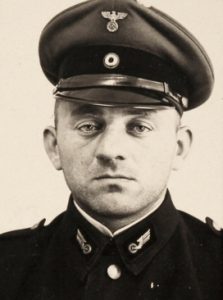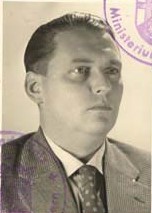With no lights, criminals could almost roam free; on average, every night one Berliner was murdered. Elfriede might have noticed someone moving in the shadows, or perhaps she never saw her killer before her skull was crushed with a blunt object and she was thrown from the train. Nearby and only an hour later, another woman, 19-year-old Irmgard Freese, was raped and beaten to death.
The S-Bahn killer had struck again.
The Nazi party obstructed the case
The case of the S-Bahn Killer was a top priority for Berlin’s police department. It was handed to the experienced police commissioner, SS-Hauptsturmführer Wilhelm Lütke. However, his task was made more difficult by the Nazi party, who did not want anything published that could damage the morale of the people. Consequently, Lütke had no way of using the press to warn people or seek information from potential witnesses.
SS-untersturmführer Georg Heuser
Wilhelm Lütke did, however, receive the help of a brilliant and idealistic young policeman, Georg Heuser, who had joined the force in February 1941. Together, they used ingenious and, at the time, novel methods to track down their killer. This included psychological profiling, fingerprint analysis, and undercover agents dressed as women who rode the trains at night to lure out the killer.
Railway man Paul Ogorzow
All the killings had taken place on and around the S-Bahn, so Lütke and Heuser’s investigation narrowed the search to railway workers. After interviewing thousands of people working on the S-Bahn, they finally got a tip that Paul Ogorzow often spoke with colleagues about his fascination with killing. One even noted that he frequently jumped the fence of the railway depot during work hours.

Paul Ogorzow. By Landesarchiv Berlin – Original publication: Landesarchiv BerlinImmediate source: https://historyofyesterday.com/berlins-nazi-serial-killer-99fb150d4864, Fair use, https://en.wikipedia.org/w/index.php?curid=70775182
Executed by guillotine
Ogorzow was finally arrested on July 12, 1941, after one of his colleagues reported his suspicious behavior and his resemblance to a composite sketch of the killer. Blood spatter was found on his uniform, which he claimed was from his wife, with whom he had had sex during her period. Ogorzow denied the crimes and without modern-day DNA analysis, this could not readily be disproven.
This time around, Lütke also met resistance from the Nazi party. Ogorzow had been a member since the early days and was an “Aryan”. The Nazi doctrine would have preferred the murderer to be a Jew or some other perceived enemy of the state. However, Ogorzow finally broke and admitted his guilt when he was faced with one of his surviving victims. He claimed that he was driven by a hatred of women, a sexual compulsion, and a grudge against a Jewish doctor who had treated him for gonorrhea.
Paul Ogorzow was charged with eight murders, six attempted murders, and 31 cases of sexual assault. He was promptly sentenced to death and beheaded the next morning in Plötzensee prison.
The mass murderer who killed 70.000 people
The young police assistant, Georg Heuser’s success in solving the S-Bahn case earned him recognition and promotion. This opened new career opportunities in the Nazi state. Thus, he was called upon to join the Einsatzgruppen, who worked behind the Eastern Front in the Soviet Union and was promoted to SS-obersturmführer.
Authorship: State Criminal Police Office (LKA) in Rhineland-Palatinate. http://www.rothenburg-unterm-hakenkreuz.de/wie-ging-die-bundesrepublik-mit-den-ns-taetern-in-kzs-an-der-front-oder-am-schreibtisch-um-wie- mit-den-vollstreckern-in-rathaeusern-verwaltungen-und-ministerien-fallbeispiele/, Fair Use, https://ru.wikipedia.org/w/index.php?curid=7700861
He was sent to Riga and later Minsk to serve as a leader of a mobile killing squad. This “Sonder-kommando” massacred thousands of Jews and other civilians in Belarus. Later he became the head of the Gestapo in Minsk and was responsible for even more atrocities and war crimes. The hero who had helped serve justice on a serial killer had become worse than the villain.
Justice?
After the war, he returned to Germany, forging a new identity, and working various odd jobs. Eventually, he resumed his career as a criminal investigator, becoming the head of the state criminal police in Rhineland-Palatinate. Georg Heuser was seemingly getting away with genocide.
However, this was not to be. He was arrested in 1959 and tried for his crimes in 1963. Georg Heuser was convicted of murdering 11,103 people and sentenced to life imprisonment. But he did not remain bars for long, as he was released in 1975 due to ill health and died in 1989.
Heuser’s story is a chilling reminder of how a once decent man could become a sadistic monster. All it might take is the influence of ideology and war. His initial pursuit of justice, only to later be swayed into committing unspeakable atrocities, demonstrates the profound and dangerous effects that political ideology and power can have on an individual.


